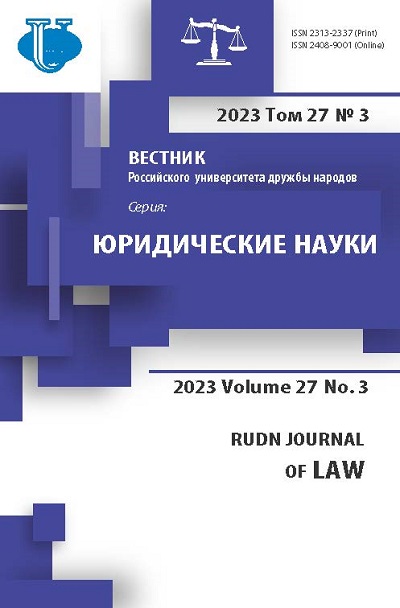The levels of information objectification in the context of legal protection ability
- Authors: Odintsov S.V.1, Lazareva E.A.2
-
Affiliations:
- RUDN University
- RedSquare Advisors (RSA Legal)
- Issue: Vol 27, No 3 (2023)
- Pages: 670-685
- Section: LAW AND DIGITAL TECHNOLOGIES
- URL: https://journals.rudn.ru/law/article/view/36137
- DOI: https://doi.org/10.22363/2313-2337-2023-27-3-670-685
- EDN: https://elibrary.ru/HMMSRH
- ID: 36137
Cite item
Full Text
Abstract
The subject of the study is the essential content and interpretation of the essence of “information”, its symbolic metaphysics. The emphasis is on the sign-symbolic level of perception of information, as well as its meaning (significance) of the sequence in the subsequent interpretation of information. Special attention is paid to the analysis of the concept of “information”. including as a result of intellectual activity. Also discusses the legal mechanisms that are designed to regulate such a multi-border phenomenon as “information”. The conclusions are formulated that due to the original immaterial (ideal) nature of information, including for the purpose of its perception, it is inextricably linked with the corresponding material (physical) carrier, which acts as a form for its objectification, thereby the form and content of information are inextricably linked within the framework of the regulation of the information exchange process. Based on the research carried out, the authors define and substantiate the concept of systematization of legal regimes of information, which is based on the levels of its objectification.
About the authors
Stanislav V. Odintsov
RUDN University
Author for correspondence.
Email: odintsov-sv@rudn.ru
ORCID iD: 0000-0002-3403-3519
Candidate of Legal Sciences, Associate Professor of the Department of Civil Law and Procedural Law and Private International Law, Law Institute
6 Miklukho-Maklaya str., Moscow, 117198, Russian FederationElizaveta A. Lazareva
RedSquare Advisors (RSA Legal)
Email: lazareva99ea@mail.ru
ORCID iD: 0000-0002-1971-202X
Counsel
50 2nd Aviamotornaya str., Moscow, 117198, Russian FederationReferences
- Chomsky, N. (1957) Syntactic Structures. The Hague, Mouton.
- Deputat, I.S., Gribanov, A.V. & Nekhoroshkova, A.A. (2012) Intelligence neurobiological fundamentals. Human ecology. (12), 36-45. (in Russian).
- Fichte, J.G. (1793) Beweis der Unrechtmäßigkeit des Büchernachdrucks. Ein Räsonnement und eine Parabel. Berlinische Monatsschrift. 443-482. (in Germani).
- Fleishits, E.A. (2015) Selected Works on Civil Law. In two volumes. Vol. 1. Moscow, Statut Publ. (in Russian).
- Gavrilov, E. (2010) Right to publish the work. Economy and Law. 4(399), 31-39. (in Russian).
- Kohler, J. (1880) Das Autorrecht: eine zivilistische Abhandlung; zugleich ein Beitrag zur Lehre vom Eigenthum, vom Miteigenthum, vom Rechtsgeschäft und vom Individualrecht. Jena. (in Germani).
- McCarty, L.Th. (1989) A language for legal Discourse I. basic features. In: Proceedings of the 2nd international conference on Artificial intelligence and law (ICAIL '89). Association for Computing Machinery, New York, NY, USA. pp. 180-189. https://doi.org/10.1145/74014.74037
- Odintsov, S.V. (2019) Digital rights - for the digital age. Modern Law. (9), 74-77. https://doi.org/10.25799/NI.2019.91.48.014 (in Russian).
- Pavlov, I.P. (1951) Selected Works. Vol. 3, book 2. Moscow, Gospolitizdat Publ. (in Russian).
- Ponkin, I.V. & Redkina, A.I. (2019) Citation as a method of support and maintenance of scientific research. Moscow, Infra-M Publ. https://doi.org/10.12737/monography_5bffa313a6f0 b3.99378392 (in Russian).
- Rozhkova, M.A. (2021) Plagiarism and other types of incorrect borrowings in dissertations: legal and ethical issues. Journal of the Court of Intellectual Rights. 3(33), 121-140. (in Russian).
- Sergeev, A.P. (1994) Russian Copyright. Saint Petersburg, Publishing House of Saint Petersburg University. (in Russian).
- Slesaryuk, N.V. (2010) Trade secret legal regime. Vestnik of Omsk law institute. 1(12), 35-37. (in Russian).
- Shershenevich, G.F. (1907) Coursebook of Russian civil law. Moscow, Spark Publ. (in Russian).
- Vitko, V.S. (2020) On the concept of "form of the work" in copyright. Patents & licenses. Intellectual rights. (10), 56-62. (in Russian).
- Voevodin, A.P. (2014) Information and sense. Bulletin of Mariupol University. (7), 7-21. (in Russian).
- Vygotsky, L.S. (1982) Selected Works. In six volumes. Vol. 2. Problems of general psychology. Moscow, Pedagogika Publ. (in Russian).
Supplementary files















